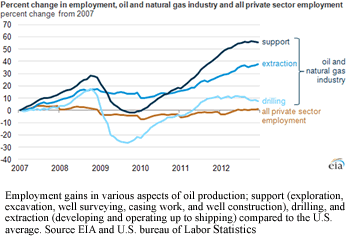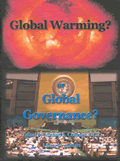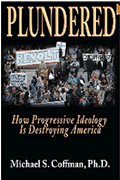THE GLOBAL FINANCIAL
DEATH SPIRAL?
PART 6
By
Kristie Pelletier and Michael S. Coffman, Ph.D
September 29, 2013
NewsWithViews.com
Part VI—The Success of Austrian Economics
President Reagan came into the White House facing an economy as troubled as ours – one that had even higher unemployment, catastrophic interest rates (18% for mortgages) and a stock market that in real terms had fallen 60% from its mid-1960s levels. When he left office eight years later, the U.S. had become an economic miracle. Steve Forbes, Wall Street Journal,March 22, 2011.
Austrian Economics
While it can probably be said that there is no perfect economic model, Austrian economics and its variants probably come the closest according to an increasing minority of economists.
Austrian Economics is the opposite of Keynesian economics. In its purist form, Austrian economics centers on the culmination of human effort, which can be achieved only through the combined decisions and judgments of individuals and cannot be forced by an external agency such as a government. It emphasizes complete freedom of association and sovereignty of individual property rights.[1] Its other main tenets include (1) abolishment of central banks and return to the gold standard, (2) elimination of bank deposit insurance schemes so that bank failures punish bad investments and bad judgments of individuals.
The theory of Austrian economics was originally crystallized in 1871 in Vienna by Carl Menger. It went through several evolutions which were unified by Nobel laureate in economics, Friedrich von Hayek and Ludwig von Mises in the 20th century. Today Ludwig von Mises Institute is the primary promoter of Austrian economics in the U.S. Most of its recommendations have been fiercely opposed by the mainstream (both capitalist and socialist) economists who call it 'anarchist economics,' probably because economists would lose all god-like power to manipulate the Fed, making the Fed unnecessary. Opposition is beginning to change as it is becoming obvious that the Keynesian model has consistently failed.
One of the biggest problems today with Keynesian economics (at least for progressives) is the fundamentally incorrect idea that job creation is the primary reason for government stimulating business. In the Keynesian model, business is but a necessary evil to creating jobs. Since business (i.e. capitalism or free market enterprise) is fundamentally evil to progressives, then mountains of regulations must be imposed to protect labor and jobs, while somehow magically creating jobs through government stimulus.
It’s the proverbial“cart before the horse” problem that is inherent to progressives and other liberals. No matter how hard they try, a goal of job creation cannot by itself cause jobs to be created. Job creation is an outcome of creating a healthy business climate.It is business and industry that pulls the economy, not jobs. That should be a no-brainer, but progressives are blind to it, probably because of their hatred of free market enterprise. Because Keynesian economics has it backwards, it has always been bound to fail; no matter how many millions of words so-called brilliant economists write telling us otherwise.
In contrast to the Keynesian model that calls for big government and regulations to control almost everything, the Austrian model holds that abundant jobs are created when business is encouraged through minimum taxes, government and regulations. This allows personal decisions to be made both in the demand (I want a product) and supply (I will produce something to meet that demand) sides of the economic equation.
Oil and Natural Gas—A Real World Example
A real world example of enormous economic success is that cheap energy literally drives our economy. The need of people and business for cheap energy is the “demand” part of the economic equation. The coal, oil and gas industry is the “supply”side of the equation. The industry knows the American culture wants a clean environment so it builds environmental protection into its process.[2]
So far, government is not in the equation at all. It is individual choice. Government may have to impose regulations to protect the environment or people from an unnecessary risk that the company may be willing to take. Regulations are also needed to level the competitive playing field. Such tensions between business and government will always exist. The free market demands, however, that those regulations must be minimal, and not based on the contrived risks that the EPA now applies for almost every regulatory decision.
Fracking is now providing that cheap energy in the U.S. The benefits to the average American are staggering. A traditional well might produce 50 barrels of oil a day during its lifetime of 2-3decades. Newly fracked wells have been known to produce over 7,000 barrels a day. However, that torrent will slow to a trickle in as a little as 18 months. Even so, using those numbers, the fracked well will initially out-produce the traditional well by 1.5 to 2 million barrels in one year!
The same staggering benefits have occurred in the pricing of oil and natural gas. The U.S. EIA reports prices for wellhead natural gas plummeted from a high of more than $8/Mcf in2008 to about $1.94 Mcf briefly in April 2012. The price should stabilize at less than $4/Mcf even when the U.S. begins to export natural gas for the first time ever, starting in 2015-2016. Although not as dramatic, wellhead oil prices of the U.S. and the world would also exhibit similarly favorable price advantages for the U.S.In contrast to the U.S., at the end of 2012 the price for Japanese gas was around $18 per Mcf and European gas was around $11 per Mcf. Compared to the expected $3-4 per Mcf for U.S. natural gas, the rest of the world cannot compete with America.
The
U.S.
Energy Information Administration (EIA) reports that the oil and
 natural
gas industry has increased jobs by 40 percent since 2007, compared to
1 percent for the total U.S. private sector. Out of slightly more than
one million jobs created during the period, the oil and natural gas
industry accounted for 140,000 of them. Says the EIA:
natural
gas industry has increased jobs by 40 percent since 2007, compared to
1 percent for the total U.S. private sector. Out of slightly more than
one million jobs created during the period, the oil and natural gas
industry accounted for 140,000 of them. Says the EIA:
Beyond within-sector employment, oil and gas industry activity also directly supports output and employment in other domestic sectors, such as suppliers of pipe, drilling equipment, [etc.]. In addition, as with other forms of economic activity, there are indirect employment effects stemming from purchases made by industry and employees spending of their incomes... A recent TIE article reviews the experience of North Dakota, which has seen significant gains in real gross domestic product per capita, coinciding with the development of the Bakken shale play.
The Manhattan Institute reports that ten million Americans are currently employed directly or indirectly in businesses connected to oil, natural gas and coal production. For every hydrocarbon job, six jobs are added in sectors from manufacturing to information services. The economic benefits that come from privately-financed expansions in domestic production would generate at least $2 trillion. In terms of monetary to social equivalence, each hydrocarbon job, on average, brings in $500,000 of societal benefit. Even if the Manhattan Institute has overestimated the economic benefits, the numbers would still be staggering. The U.S. could once more be a net exporter of energy and many finished products.
Following the development of the Bakken shale play (field), North Dakota’s Gross Domestic Product (GDP) went from $33,000 per capita to $55,200 per capita in 2012 – more than 29 percent above the national average. Since 2007, North Dakota’s (GDP) has grown by a rate of 39 percent annually – 42 percent in 2012 alone.
Stansberry Research effuses that “This new oil shale boom is the biggest revolution to the energy sector the world has seen. These new gushers are bigger – far bigger – than anything in the history of the oil business in the U.S. They're like finding 20 new Persian Gulf fields… right here in America. ”Stansberry, predicts: “The resulting oil boom, underway right now, will become the greatest creation of wealth in America's history.” (Emphasis original)
The implications of this go far beyond the cheap energy aspect of fracking. It is possible, even probable, that this miracle could neutralize every one of the potential economic disasters discussed in the previous five parts of this Financial Death Spiral series. It depends on what the Obama administration does in the next two years.
The Obama/Keynesian/Progressive Factor
Unfortunately, only part of this economic miracle will happen if President Obama continues his dogmatic progressive ideology and dependence on Keynesian economic policies. Fracking has allowed the U.S. to boost U.S. oil production from 119 million barrels per month in 2008 to 227 million barrels in May of 2013 according to the eia – a 91 percent increase.
Although Obama has claimed he was responsible for this huge increase since he took office, in fact, he had systematically done all he could to block development of oil in the U.S. Most of the permits for federal land or off-shorethat account for the huge increase today were granted by the Bush administration, or were on private land where Obama did not have veto power. He has severely restricted oil and gas shale development when he can. The Keystone XL pipeline is but one example.
Ironically, we may have become energy independent already if progressive Senator Ken Salazar (D-CO) hadn’t blocked many of President Bush’s efforts to tap into this new oil bonanza in the early 2000s. As Secretary of Interior during Obama’s first term, Salazar still lead Obama’s efforts to put the brakes on, or actually shut down the coal, oil, and natural gas industries. This continues to have a devastating impact on the economy and job sin Obama’s second term.
President Obama says oil and gas is still a component of his energy plan, probably because he can’t stop oil and gas development on private land. However, he has reduced support of oil and natural gas development and has spent close to $80 billion to force America to convert to green energy. He and former Secretary of Energy Chu have actually stated they wanted energy prices to “skyrocket” to European levels so their green energy schemes are competitive. Worse, corruption seems to be the result of “investing” in green energy, as one company after another that accepted federal dollars wind up in bankruptcy. As investigations by the U.S. House of Representatives have shown, most of that money was spent on flagrant crony capitalism to reward Obama supporters.
So far, Obama has continued his ideological stand established during his first four years of opposing oil and gas by only issuing needed export licenses at glacial speed. Right now there are no liquefied natural gas (LNG) export terminals in operation in the U.S. Although eight large-scale LNG export facilities are scheduled to open in 2015-16, only three have received licenses to operate; years after they applied.
Unless Obama trashes his progressive ideology and is willing to modify his economic theory to a more Austrian orientation, this oil-gas boon is likely to go unrealized and we will still be on the road to economic disaster. After all, the Keystone XL pipeline from Canada was studied for years, found safe and actually approved by the State Department when, after hemming and hawing for over a year, Obama “postponed” it indefinitely for “further study.” We only need to look to Europe’s green energy disaster discussed in Part V of this Financial Death Spiral series to see what awaits the U.S. if we go farther down the green energy road.
Other Examples of Austrian Economic Successes
Critics of Austrian economics often demand to be provided with examples of past economic successes of the theory. Although it is not an example of pure Austrian economics (again, no economic model is “pure,” including Keynesian economics), the miraculous recovery from the Forgotten Depression by Presidents Harding and Coolidge is a case in point.
Prior to the Wilson election in 1912, federal spending was 2 percent of the Gross National Product (GNP); about the same as the preceding one hundred years. During the Wilson administration, it jumped to over 7 percent. The non-defense federal budget went from about $66 billion annually (in 2013 dollars) to a whopping $854 billion. Wilson also raised the income tax rate from 7 percent to 73 percent for the rich during his administration, while only increasing from 1 percent to 4 percent for the lowest tax bracket earning $2,000 a year or more.
The whiplash effect of Wilson’s wild increase in non-defense spending and tax increases resulted in the 1920-1921 depression. Just like President Obama today, President Wilson attempted to spend his way out of the looming depression by dramatically increasing federal spending and taxing the rich. Like President Obama today, he failed. By 1920 unemployment had jumped to nearly 12 percent,[3] and GNP declined 17 percent – the same general pattern as experienced from 2008-2013. In spite of the Federal Reserve, or because of it, the economy was a disaster.
When Warren Harding took office as president in 1921, he imposed an anti-Keynesian solution by slashing taxes from 73 percent in 1921 to 25 percent by 1925. Taxes were cut for lower incomes starting in 1923. Instead of trying to stimulate the economy like Wilson had done, Harding cut the government's budget nearly in half between 1920 and 1922. The result? The national debt was reduced by one-third. By 1922 unemployment was down to 6.7 percent, and by 1923 it had dropped to 2.4 percent. The depression had vanished and The Roaring Twenties were launched.
Economic historian Thomas Woods Jr. reflects on Harding’s enormous success: “The federal government did not do what Keynesian economist sever since have urged it to do: run unbalanced budgets and prime the pump through increased expenditures. Rather, there prevailed the old-fashioned view that government should keep taxation and spending low and reduce the public debt.” It speaks volumes as to why President Obama’s Keynesian economic plan of stimulus and enormous deficit spending have not worked. The only thing Obama and other modern-day progressives in Congress have done is to bring us to the brink of total economic collapse – just like President Wilson did in the early 1920s.
Why don’t these modern-day progressives learn from the Harding miracle? A large part of the answer comes from the progressives’ efforts to re-write history. Progressives throughout the twentieth century have revised U.S. history with a vengeance to conform it to their failed ideology. Progressive historians have reduced Harding’s miracle to a footnote in history books, if it is mentioned at all. Incredibly, progressive historians usually label Harding ‘the worst president in history.’
Harding suffered from what is now a well-established strategy practiced by progressives – demonize and marginalize anyone who disagrees with the progressive view of reality, in this case Keynesian economics. Since Harding’s miracle is essentially erased from economic history and can’t challenge Keynesian dogma, progressives today are doomed to repeat the same failed policies over and over again. In a very real way, progressives are trapped in their own distortions of history.
When Harding died in office in 1923, Calvin Coolidge continued his free-market policies which fueled the Roaring Twenties. Coolidge served the balance of Harding’s term following his death in 1923 and won the 1924 election for an additional four years as president. During his presidency he kept taxes low and government small. He declined to run for a second term in 1928.
The Miracle of Hong Kong
Another Austrian success story is the miracle of Hong Kong. Writing in the Ludwig von Mises Institute, D.W Mackenzie recaps the story:
After the Second World War Hong Kong had no minimum wage, low and simple taxes, zero tariffs, [z]ero capital controls, and a stable legal environment. The government in Hong Kong invested in its seaport and public education, but public spending ranged from 13-19% of GDP. Hong Kong has also avoided accumulation of public debt. Hong Kong actually ran budget surpluses in 32 years between 1948 and 1985. Hong Kong is an excellent example of a free market-limited government society, but how well did this example of laissez faire work?
At the end of the Second World War annual per capita income was $180. By 1982 the per capital income of Hong Kong was $6,000. Even the lowest 20% of Hong Kong households reached $1300 per capita income by 1976 - seven times the average income just after the war. From the mid-fifties to the 1970's Real wages in Hong Kong more than doubled, and unemployment fell below 3%.
From 1948 to 1960 Hong Kong’s GDP grew at a rate of 7% per year. From 1961 to 1980 Hong Kong’s GDP grew 9% per year. From 1979 to 1984 Hong Kong’s GDP grew 7.6%, despite a worldwide recession. All of this happened without foreign direct aid of any kind.
Postwar Hong Kong went as far with economic laissez faire as any other country in history. This resulted in economic development that benefited virtually all the people of Hong Kong. Living standards increased substantially even for the poorest people in Hong Kong. There are other examples too, like postwar West Germany. The architect of the postwar West German ‘economic miracle’ was Wilhelm Ropke. Ropke was influenced by the writing of Ludwig von Mises, so the success of laissez faire in postwar West Germany can be directly attributed to Austrian Economics. This is only one example, but economic freedom indexes provide further evidence of the success of laissez faire economics.
Today, the International Monetary Fund reports Hong Kong’ per capita GNP has risen to 25th out of 182 nations in the world. Perhaps the best response to a progressive’s challenge to the vastly superior free market concept of Austrian economics was given by President Reagan’s economic advisor Milton Friedman in a 1979 interview with Phil Donahue. Donahue tried to pin Friedman down by asking him, “When you see around the globe the mal-distribution of wealth, the desperate plight of millions of people in underdeveloped countries, when you see so few haves and so many have-nots, when you see the greed and the concentration of power, did you ever have a moment of doubt about capitalism and whether greed’s a good idea to run on?” Friedman calmly responded;
Well, first of all, tell me is there some society you know that doesn’t run on greed? You think Russia doesn’t run on greed? You think China doesn’t run on greed? …The world runs on individuals pursuing their separate interests. The great achievements of civilization have not come from government bureaus. Einstein didn’t construct his theory under order from a bureaucrat. Henry Ford didn’t revolutionize the automobile industry that way. In the only cases in which the masses have escaped from the kind of grinding poverty you’re talking about, the only cases in recorded history are where they have had capitalism and largely free trade. If you want to know where the masses are worst off, it’s exactly in the kinds of societies that depart from that. So that the record of history is absolutely crystal clear: that there is no alternative way so far discovered of improving the lot of the ordinary people that can hold a candle to the productive activities that are unleashed by a free enterprise system. (Italics added)
To this Donahue responded, “But it seems to reward not virtue as much as ability to manipulate the system.” Friedman answered:
| Subscribe to the NewsWithViews Daily News Alerts! |
And what does reward virtue? You think the communist commissar rewards virtue? You think a Hitler rewards virtue? You think – excuse me, if you will pardon me – do you think American presidents reward virtue? Do they choose their appointees on the basis of the virtue of the people appointed or on the basis of their political clout? Is it really true that political self-interest is nobler somehow than economic self-interest? You know I think you are taking a lot of things for granted. Just tell me where in the world you find these angels who are going to organize society for us? Well, I don’t even trust you to do that.
To this Donahue had absolutely no response. That’s because there is none.













 Share
This Article
Share
This Article





